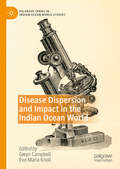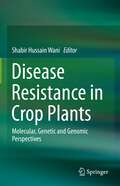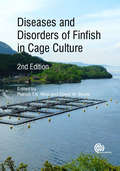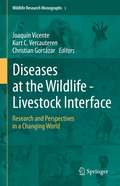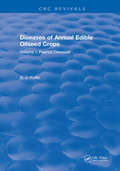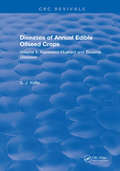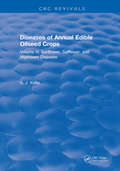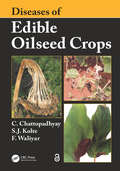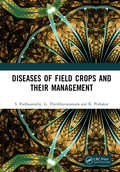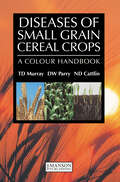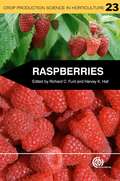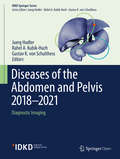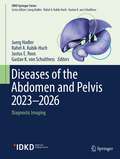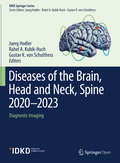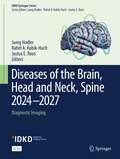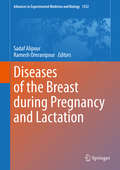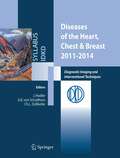- Table View
- List View
Disease Dispersion and Impact in the Indian Ocean World (Palgrave Series in Indian Ocean World Studies)
by Gwyn Campbell Eva-Maria KnollThis volume views the study of disease as essential to understanding the key historical developments underpinning the foundation of contemporary Indian Ocean World (IOW) societies. The interplay between disease and climatic conditions, natural and manmade crises and disasters, human migration and trade in the IOW reveals a wide range of perceptions about disease etiologies and epidemiologies, and debates over the origin, dispersion and impact of disease form a central focus in these essays. Incorporating a wide scope of academic and scientific angles including history, social and medical anthropology, archaeology, epidemiology and paleopathology, this collection focuses on diseases that spread across time, space and cultures. It scrutinizes disease as an object, and engages with the subjectivities of afflicted inhabitants of, and travellers to, the IOW.
Disease Resistance in Crop Plants: Molecular, Genetic and Genomic Perspectives
by Shabir Hussain WaniHuman population is escalating at an enormous pace and is estimated to reach 9.7 billion by 2050. As a result, there will be an increase in demand for agricultural production by 60–110% between the years 2005 and 2050 at the global level; the number will be even more drastic in the developing world. Pathogens, animals, and weeds are altogether responsible for between 20 to 40 % of global agricultural productivity decrease. As such, managing disease development in plants continues to be a major strategy to ensure adequate food supply for the world. Accordingly, both the public and private sectors are moving to harness the tools and paradigms that promise resistance against pests and diseases. While the next generation of disease resistance research is progressing, maximum disease resistance traits are expected to be polygenic in nature and controlled by selective genes positioned at putative quantitative trait loci (QTLs). It has also been realized that sources of resistance are generally found in wild relatives or cultivars of lesser agronomic significance. However, introgression of disease resistance traits into commercial crop varieties typically involves many generations of backcrossing to transmit a promising genotype. Molecular marker-assisted breeding (MAB) has been found to facilitate the pre-selection of traits even prior to their expression. To date, researchers have utilized disease resistance genes (R-genes) in different crops including cereals, pulses, and oilseeds and other economically important plants, to improve productivity. Interestingly, comparison of different R genes that empower plants to resist an array of pathogens has led to the realization that the proteins encoded by these genes have numerous features in common. The above observation therefore suggests that plants may have co-evolved signal transduction pathways to adopt resistance against a wide range of divergent pathogens. A better understanding of the molecular mechanisms necessary for pathogen identification and a thorough dissection of the cellular responses to biotic stresses will certainly open new vistas for sustainable crop disease management. This book summarizes the recent advances in molecular and genetic techniques that have been successfully applied to impart disease resistance for plants and crops. It integrates the contributions from plant scientists targeting disease resistance mechanisms using molecular, genetic, and genomic approaches. This collection therefore serves as a reference source for scientists, academicians and post graduate students interested in or are actively engaged in dissecting disease resistance in plants using advanced genetic tools.
Diseases Of Nematodes: Volume I
by George O PoinarThe present work deals with the diseases of nematodes. Although the term disease implies a pathological condition brought about by an infectious agent, a broader concept is used here.
Diseases Of Nematodes: Volume II
by George O PoinarThe present work deals with the diseases of nematodes. Although the term disease implies a pathological condition brought about by an infectious agent, a broader concept is used here.
Diseases and Disorders of Finfish in Cage Culture
by David Bruno L Lim Patrick WooThis new edition is a timely update on important advances in the understanding of infectious diseases of finfish. The content has been significantly updated to reflect current knowledge and the developments in the fish production industry, including the dramatic increases in production in the Asia-Pacific region. An important resource for aquaculturalists, fish health consultants and fish pathologists.
Diseases and Disorders of Finfish in Cage Culture
by David W. Bruno Patrick T.K. WooThis new edition is a timely update on important advances in the understanding of infectious diseases of finfish. The content has been significantly updated to reflect current knowledge and the developments in the fish production industry, including the dramatic increases in production in the Asia-Pacific region. An important resource for aquaculturalists, fish health consultants and fish pathologists.
Diseases and Parasites of the Eastern Oyster, Crassostrea Virginica, in Chesapeake Bay: An Illustrated Reference Guide
by Christopher F. Dungan Ryan B. Carnegie Carol B. MccolloughThis publication supports the development of oyster aquaculture industries and restored populations of wild oysters in the eastern United States. Both aquaculture and efforts to restore the eastern oyster, Crassostrea virginica, have expanded in recent years, increasing the need for a broader understanding of oyster health. <p><p>This volume addresses that need by providing detailed information on the histological presentation of diseases and parasites affecting eastern oysters.
Diseases at the Wildlife - Livestock Interface: Research and Perspectives in a Changing World (Wildlife Research Monographs #3)
by Joaquín Vicente Kurt C. Vercauteren Christian GortázarShared diseases among wildlife, livestock and humans, often transboundary, are relevant to public health and global economy, as being highlighted currently relative to the global COVID19 pandemic. Diseases at these interfaces also impact the conservation of biodiversity and must be considered when managing wildlife. While wildlife and domestic livestock have coexisted in dynamic systems for thousands of years, spillover disease risks are higher today than in the past due to global patterns of increasing close contact and interactions among wildlife, livestock and humans in the context of complex, diverse and numerous circumstances. Multidisciplinary studies of animal interfaces, especially those involving wildlife, therefore, must be brought to the forefront so that knowledge gaps can be realized and filled to inform managers and policy makers.In the first part of the book authors illustrate and discuss ecological and epidemiological concepts related to the interfaces, with a vision towards socio-ecological system health. In addition, the history of past animal interfaces provides the necessary perspective to focus current questions, better understand present situations, and informs how we can best approach the future. The second part discusses the myriad of similar and differing wildlife- livestock interfaces found around the world from a regional point of view. The third part focuses on how to assess the spatial and temporal overlap between livestock and wildlife, and authors present new technical innovations about how inter-transmissions between wild and domestic populations can be quantified. An overview of main modeling approaches available to quantify multi-host disease transmission at the wildlife/livestock interface, illustrated with specific-case studies, is also presented. Finally, the need for interdisciplinary approaches and a dedicated thematic field to approach the wildlife/livestock interfaces and create opportunities to promote wildlife–livestock coexistence is emphasized. The concluding chapter presents perspectives and directions to better understanding disease dynamics at the wildlife/livestock interface, global change and implications for the future. The changing distribution of interfaces, ongoing human and environmental changes (e. g. climate warming, changes in animal production systems, etc.) and their likely impacts and consequences for the interfaces and disease transmission processes are all discussed.
Diseases in Legume Crops: Next Generation Breeding Approaches for Resistant Legume Crops
by Harsh Nayyar Kadambot H. M. Siddique Prashant Singh Uday Chand Jha Kamal Dev Sharma Eric J Bishop von WettbergThe edited book covers all major and minor diseases in grain legumes (chickpea, pigeon pea, lentil, mung bean, common bean, groundnut, and soybean) and forages legumes (including Medicago, rice bean, and faba bean) and their control measures by using various breeding approaches.Grain legumes are versatile nutritionally rich crops, and are one of the important components of global food security. However, grain legumes are severely challenged by various major and emerging minor diseases causing serious limitations in grain yield and production. Thus, to minimize the negative impact of the growing yield loss caused by these diseases, several approaches have been developed and embraced. This book covers all the latest development in genetics, breeding, genomics, and molecular biology tools for combating various major and minor emerging diseases in all the grain legumes from expert authors. Chapters in this title contain all the relevant illustrations and statistical data detailing the present scenario and identifying the gap for meeting the future demand for sustaining global protein security by developing disease-resistant cultivars. This book is of interest to graduate and postgraduate students, researchers, and policymakers to understand the impacts of various diseases on yield loss in legume crops.
Diseases of Annual Edible Oilseed Crops: Volume I: Peanut Diseases
by S. J. KolteThese three volumes deal with the diseases of primarily cultivated annual edible oilseeds, i.e., peanut (groundnut), rapeseed-mustard, sesame, sunflower, safflower, and nigerseed. It is reliably believed that this book will be of great help not only to students, reseachers, and teachers but also to agricultural extension workers, field workers, seed growers, and seed crop inspectors, and subsequently to the farmers, to achieve the over-all objective of increase in oilseed crop yields throughout the world.
Diseases of Annual Edible Oilseed Crops: Volume II: Rapeseed-Mustard and Sesame Diseases
by S. J. KolteThese three volumes deal with the diseases of primarily cultivated annual edible oilseeds, i.e., peanut (groundnut), rapeseed-mustard, sesame, sunflower, safflower, and nigerseed. It is reliably believed that this book will be of great help not only to students, reseachers, and teachers but also to agricultural extension workers, field workers, seed growers, and seed crop inspectors, and subsequently to the farmers, to achieve the over-all objective of increase in oilseed crop yields throughout the world.
Diseases of Annual Edible Oilseed Crops: Volume III: Sunflower, Safflower, and Nigerseed Diseases
by S. J. KolteThese three volumes deal with the diseases of primarily cultivated annual edible oilseeds, i.e., peanut (groundnut), rapeseed-mustard, sesame, sunflower, safflower, and nigerseed. It is reliably believed that this book will be of great help not only to students, reseachers, and teachers but also to agricultural extension workers, field workers, seed growers, and seed crop inspectors, and subsequently to the farmers, to achieve the over-all objective of increase in oilseed crop yields throughout the world.
Diseases of Edible Oilseed Crops: Volume Ii: Rapeseed-mustard And Sesame Diseases
by Chirantan ChattopadhyayDiseases of Edible Oilseed Crops presents an unprecedentedly thorough collection of information on the diseases of cultivated annual oilseed crops, including peanut, rapeseed-mustard, sesame, soybean, sunflower, and safflower. Written by internationally recognized researchers, this book covers and integrates worldwide literature in the field up to
Diseases of Field Crops and their Management
by S. Parthasarathy G. Thiribhuvanamala K. PrabakarThe book entitled Diseases of Field Crops and their Management provides most recent information about major diseases of cultivation field crops, their symptoms, pathogen characters, epidemiology, and management. In order to make the book all in one, the importance of major diseases has also been dealt with in brief. Note: T&F does not sell or distribute the Hardback in India, Pakistan, Nepal, Bhutan, Bangladesh and Sri Lanka.
Diseases of Field Crops: Diagnostics and Management
by Krishna Pratap Singh Vaibhav Kumar Singh Jameel AkhtarThis edited book is a compilation of the chapters on the recent advances made in the field of disease management in various field crops. It covers host resistance, regulatory mechanism as well as non-chemical methods and computer-based applications in disease management. Molecular marker assisted selection, proteomic approaches, CRISPR-Cas mediated technology to improve food quality and minimize negative public health impact associated with crop diseases is also discussed. Plant diseases continue to be major challenge to global crop production, especially field crops, inflicting not only crop yield losses to farmers, but also decline quality as well as nutritional value leading threat to global food security. According to FAO statistics, there is a need of 70% steady increase in agricultural production to fulfil the food requirements of 9.1 billion populations by 2050, and annual global crop losses due to pests and diseases have been estimated to be about 30%. Therefore, the book aims at bringing out a comprehensive information on field crop diseases, plant disease detection and diagnosis, monitoring, forecasting/forewarning, and management. The book is very useful for students, teachers, researchers, planners/administrators, and also the end users at national and international level.
Diseases of Small Grain Cereal Crops: A Colour Handbook
by Nigel D. Cattlin T.D. Murray David W. ParryThe small grain cereals wheat, barley, oats and rye are cultivated worldwide. They form the foundation of most agricultural systems and are essential in the manufacture of staple products such as bread, pasta and fermented beverages. Reflecting the global and economic importance of cereal crops, this book aims to make identification of diseases aff
Diseases of Temperate Horticultural Plants
by Tim O'Neill Raymond A George Robert Saville Roland Fox Susan Mccallum Mohammad Babadoost João Pedro LuzContaining an extensive range of photographs and authored by leading horticultural experts, 'Diseases of Temperate Horticultural Plants' is an indispensable reference work for horticultural professionals, academics, students, crop producers as well as amateur horticulturists. The diseases of major crops are presented according to their classification, and the symptoms of each disease, causal pathogen and control measures for each condition are described. The crops covered include the major temperate horticultural crops, organised into easy to navigate sections divided into fruits, vegetables and ornamentals. Within fruits, apples and pears are discussed, as well as ribes and berries, cherries, peaches and plums, nut crops and rhubarb. The vegetable section covers salad crops, brassicas and crucifers, cucurbits, root vegetables, bulb crops, solanaceous vegetables and some herbs. The section on ornamental plants includes a wide range of ornamental garden plants, while a further section discusses diseases of turf grass and ornamental lawns. The book is user-friendly with practical, accessibly written entries organised into discrete sections. The comprehensive nature of this work makes it an invaluable addition to any horticulturist's library with content that will remain current for years to come.
Diseases of the Abdomen and Pelvis 2018-2021: Diagnostic Imaging - Idkd Book (IDKD Springer Series)
by Gustav K. Schulthess Rahel A. Kubik-Huch Juerg HodlerThis open access book deals with imaging of the abdomen and pelvis, an area that has seen considerable advances over the past several years, driven by clinical as well as technological developments. The respective chapters, written by internationally respected experts in their fields, focus on imaging diagnosis and interventional therapies in abdominal and pelvic disease; they cover all relevant imaging modalities, including magnetic resonance imaging, computed tomography, and positron emission tomography. As such, the book offers a comprehensive review of the state of the art in imaging of the abdomen and pelvis. It will be of interest to general radiologists, radiology residents, interventional radiologists, and clinicians from other specialties who want to update their knowledge in this area.
Diseases of the Abdomen and Pelvis 2023-2026: Diagnostic Imaging (IDKD Springer Series)
by Rahel A. Kubik-Huch Gustav K. von Schulthess Juerg Hodler Justus E. RoosThis open access book deals with imaging of the abdomen and pelvis, an area that has seen considerable advances over the past several years, driven by clinical as well as technological developments. The respective chapters, written by internationally respected experts in their fields, focus on imaging diagnosis and interventional therapies in abdominal and pelvic disease; they cover all relevant imaging modalities, including magnetic resonance imaging, computed tomography, ultrasound, and positron emission tomography. As such, the book offers a comprehensive review of the state of the art in imaging of the abdomen and pelvis. IDKD books are extensively re-written every four years. As a result, they offer a comprehensive review of the state of the art in imaging. The book is clearly structured with learning objectives, abstracts, subheadings, tables and take-home points, supported by design elements to help readers easily navigate through the text. As an IDKD book, it is particularly valuable for general radiologists, radiology residents, and interventional radiologists who want to update their diagnostic knowledge, and for clinicians interested in imaging as it relates to their speciality.
Diseases of the Brain, Head and Neck, Spine 2020–2023: Diagnostic Imaging (IDKD Springer Series)
by Rahel A. Kubik-Huch Gustav K. von Schulthess Juerg HodlerThis open access book offers an essential overview of brain, head and neck, and spine imaging. Over the last few years, there have been considerable advances in this area, driven by both clinical and technological developments. Written by leading international experts and teachers, the chapters are disease-oriented and cover all relevant imaging modalities, with a focus on magnetic resonance imaging and computed tomography. The book also includes a synopsis of pediatric imaging. IDKD books are rewritten (not merely updated) every four years, which means they offer a comprehensive review of the state-of-the-art in imaging. The book is clearly structured and features learning objectives, abstracts, subheadings, tables and take-home points, supported by design elements to help readers navigate the text. It will particularly appeal to general radiologists, radiology residents, and interventional radiologists who want to update their diagnostic expertise, as well as clinicians from other specialties who are interested in imaging for their patient care.
Diseases of the Brain, Head and Neck, Spine 2024-2027: Diagnostic Imaging (IDKD Springer Series)
by Rahel A. Kubik-Huch Juerg Hodler Justus E. RoosThis open access book offers an essential overview of brain, head and neck, and spine imaging. Over the last few years, there have been considerable advances in this area, driven by both clinical and technological developments. Written by leading international experts and teachers, the chapters are disease-oriented and cover all relevant imaging modalities, with a focus on magnetic resonance imaging and computed tomography.IDKD books are rewritten (not merely updated) every four years, which means they offer a comprehensive review of the state-of-the-art in imaging. The book is clearly structured and features learning objectives, abstracts, subheadings, tables and take-home points, supported by design elements to help readers navigate the text. It will particularly appeal to general radiologists, radiology residents, and interventional radiologists who want to update their diagnostic expertise, as well as clinicians from other specialties who are interested in imaging for their patient care.
Diseases of the Breast during Pregnancy and Lactation (Advances in Experimental Medicine and Biology #1252)
by Sadaf Alipour Ramesh OmranipourSymptoms of the breast in gravid women commonly represent physiological changes, however they may also be related to serious underlying breast disease; this challenging dilemma is aggravated by diagnostic and therapeutic limitations imposed by safety issues regarding the mother and fetus. A comprehensive coverage of all aspects of normal and pathologic breast changes during pregnancy and lactation, their diagnosis and management is provided in the present work. The organized structure of this book begins with gestational changes of the breast, while discussing safety, hazards, and arguments regarding diagnostic approaches. It then goes on by describing various clinical presentations and common and uncommon benign disorders during gravidity. The book then addresses pre-malignant lesions of the breast, opening the dialogue on how to manage these confusing lesions in pregnant and nursing women. It continues toward pregnancy-associated breast cancer, focusing on every facet of the problem, including epidemiology, diagnosis, treatment and complications, anesthetic considerations, prenatal care, and rare malignancies; and comes to an end by arguing main psychological concerns. In the midst of this orderly sequence fertility issues, pregnancy, and breastfeeding in women who have overcome their breast cancer are also discussed. This unique reference has been written by academic experts from different centers and diverse disciplines in a practical format. It is intended to be an ideal resource for every practitioner and specialist who manages complaints of gravid and nursing women or treats breast disorders in women of child bearing age.
Diseases of the Endocannabinoid System
by Matthew Fogel Elizabeth Fogel Jean-Paul Henri DedamThis book fills the need for a detailed examination of the role of Endocannabinoid System in all the body's main organ systems and how dysregulation of that system can lead to disease. It serves as an in-depth analysis of the thousands and thousands of studies on the Endocannabinoid System within the medical literature. It covers the many diseases that can result from Endocannabinoid system dysfunction, ranging from metabolic syndrome to anxiety disorders to osteoporosis. The book is written primarily for medical providers and those with a science background.
Diseases of the Heart, Chest & Breast 2011-2014
by Christoph L. Zollikofer Gustav K. Schulthess Jürg HodlerWritten by internationally renowned experts, this volume deals with imaging of diseases of heart, chest and breast. The different topics are disease-oriented and cover all the relevant imaging modalities, including standard radiography, CT, nuclear medicine with PET, ultrasound and magnetic resonance imaging, as well as imaging-guided interventions. This book presents a comprehensive review of current knowledge in imaging of the heart and chest , as well as thoracic interventions and a selection of "hot topics" of breast imaging. It will be particularly relevant for residents in radiology, but also very useful for experienced radiologists and clinicians specializing in thoracic disease and wishing to update their knowledge of this rapidly developing field.
Diseases, Pests and Disorders of Potatoes: A Colour Handbook
by Stuart Wale Bud Platt Nigel D. CattlinCovering the most important pathogens, this handbook provides clear, concise descriptions of the symptoms and cycles of diseases and disorders, and the pests that commonly prey on potato crops, their distribution and importance, and advice on their control. The text is illustrated with some 235 superb color photographs of affected crops to aid in the rapid and accurate identification of disease. It provides a practical reference for professionals and students involved with potato production, handling and storage worldwide.Diseases and Pests covered include: Potato early blight, Gray mould, Black dot, Ring rot, Blackleg, Soft rot, Pit rot, Dry rot and wilt, Violet root rot, Silver scurf, Aster yellows, Witches broom, Pocket rot, Gangrene, Pink rot, Potato late blight, Skin spot, Spraing, Mild Mosaic, Sev. Mosaic, Net Necrosis, Watery wound rot, Leak, Brown rot, Stem canker, Black Scurf, White mould, Powdery scab, Common scab, Wart, Spraing, Verticillium wilt.
